Fuel-rich propellants are typically used for ramjet-rocket motors[1]. Fuel-rich propellants are classified into metal-loaded compositions with high smoke levels, carbon compositions with moderate smoke levels and hydrocarbon-fueled compositions with low smoke level. The major components of hydrocarbon-fueled compositions are a binder, an oxidizer, and sometimes a hydrocarbon filler[2]. The propellant grain must withstand the stresses and strains imposed on it during handling, ignition, and firing of rocket[3]. The mechanical properties are so essential for the propellant to be measured to ensure its capability for storage, transportation, aging, and operating under the combustion loads[4].
For the composite solid rocket propellants, tensile mechanical tests are often applied. With elastic materials, stresses and strains are essentially proportional to each other and independent of time[5]. Temperature variations during storage are found to be the main reason for the propellant strain and stress leading to decreasing quality[6].
The variation of performance parameters with variation in formulation cannot yet be presented by mathematical models exactly. Many studies have been reported previously to correlate the individual performance properties with the formulation parameters. Marsh[7]studied the polymer parameters for formulation design and quality control, and a general correlation of mechanical properties. He concluded that there is a correlation of propellant elongation with polymer network parameter, while tensile capacity becomes a useful formulation characteristic. Hill[8]studied the effect of the plasticizer to improve the elastomeric properties of binders and hence the mechanical properties. Nian[9]studied the effect of the functionality group of hydroxyl-terminated polybutadiene pre-polymer (HTPB) on the binder network and its correlation with the mechanical properties. Keizers[10]made studies on ammonium perchlorate AP/HTPB propellants to predict some of the important parameters by developing computer model.
According to binder base, composite propellants are characterized by their excellent tensile mechanical properties, strength at maximum in the range of 5-35 kg·cm-2 and strain at maximum in the range of 25%-120% at normal temperature[11].
The objective of the present experimental investigation in the paper was to determine the effect of solid fillers, such as oxidizer solid loading and oxidizer particle size distribution, on the mechanical properties of the fuel-rich composite propellant. The mechanical properties (tensile strength, strain, and Young′s modulus) were measured and analyzed for different formulations.
2 Experimental Method 2.1 Propellant formulationsThe formulations studied in this work were formulated on the basis of HTPB as a binder and AP as an oxidizer. Further investigation includes system in which fuel, aluminum (Al), and burning rate accelerator, copper chromite (CC), added at the expense of the binder.
The compositions of all tested propellant formulations presented in Table 1. The propellant binder was composed of 85.7% HTPB as a main backbone, 12. 3% hexa-methylene di-isocianate (HMDI) as a cross-linking agent and 2. 0% methyl aziridinyl phosphine oxide (MAPO) as a bonding agent[12]. All propellant compositions contained 0.5%carbon black (CB) with 10 μm particle size as an opacifier which was found to be very important to apply the black body role[2]. The base line propellant formulation A3 consisted of 45% AP with 9.0 μm particles and the particle size variations were investigated through a bi-modal system with AP (64.0 μm)[13]. The AP average particle size in formulation B1 is 44.5 μm and in formulation B2 is 55.9 μm.
| Tab.1 The fuel-rich formulations |
Preparation of the propellants for the test program was made by using a heavy-duty mixer (9×10-3 m3 capacity) with weight of 10 kg per formulation to guarantee the slurry homogeneity. Propellant slurry casting was applied in special molds with standard dimensions l5 cm×15 cm×15 cm under vacuum and vibration. The molds are placed in a curing oven at 55 ℃, for a total curing time of 240 h. Curing temperature is selected to accelerate the cross linking reactions. After curing the molds are cut into sheets with uniform thickness of 1.2 cm.
Test specimens were produced according to Joint Army-Navy-NASA-Air Force Propulsion Committee (JANNAF) standard[14].
Fig. 1 shows the produced specimens which checked for voids (e.g. air bubbles-cracks-porosities-foreign matter) by X-Ray. After that, the accepted specimens are stored at ambient temperature in dry place.
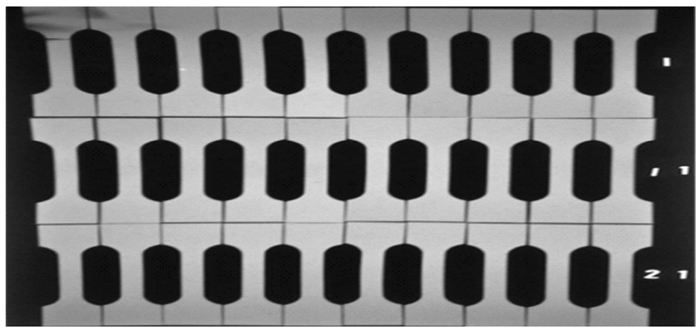
|
Fig.1 X-Ray film for JANNAF specimens |
The Zwick Z050 universal test machine was used in carrying out all the mechanical tests. The machine can do seven different mechanical tests (tensile, compression, bending, peeling, creep, relaxation, and low cycle fatigue tests). The machine is provided with 3 different load cells (2.5 kN, 10 kN, and 50 kN) to cover wide ranges of measurements and applications. The machine is supported with a temperature chamber which allow for performing tests under desired temperature.
The Shore hardness(A) was measured using the hardness tester Zwick (model 3102) at 25 ℃.
2.3 Measurement methodsTensile tests are used to determine a certain number of parameters, as shown in figure 2 that allow for better representation of propellant behavior. These parameters include: Young′s modulus (E), maximum strength (σm), maximum strain (εm) corresponding to maximum strength, break stress, break strain.
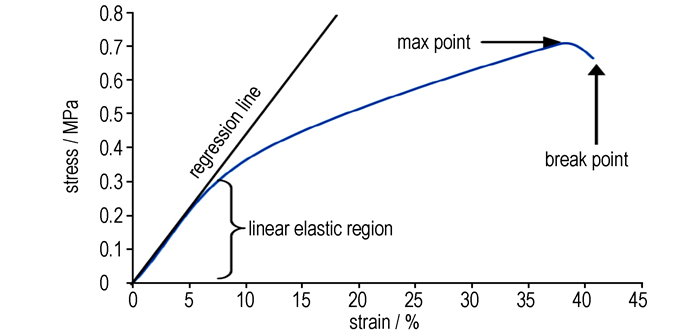
|
Fig.2 General tensile behavior of solid propellant |
Young′s modulus is determined from the linear part of the stress-strain curve. JANNAF specimens were tested at tensile rate of 50 mm/min and temperature 25 ℃. The tensile test was carried out for at least five samples for each prepared formulation and then the mean value of the obtained results was recorded.
3 Results and Discussion 3.1 ResultIn this work the regression line is calculated in the range from begin of Young′s Modulus determination to the end of Young′s Modulus determination (see Fig. 2) that indicates the parameters which can be identified from the tensile test.
The mechanical properties of the tested propellant formulations were independent on the curative ratio (NCO/OH ratio of HMDI and HTPB) in this program where NCO/OH ratio was 2.0 in all formulations (this high ratio was verified practically by preparation of different binder formulations with ratio from 0.5 to 3 then test them which lead to this value). The results of these mechanical properties with different compositions are given in Table 2.
| Tab.2 Results of mechanical properties at 25 ℃ |
According to Fig. 3, Fig. 4 and Fig. 5 increasing the binder percentage (from 34.5% to 74.5%) in group A, C, D, and E make decreasing of the maximum strength (from 35.07 kg·cm-2 to 22.51 kg·cm2 with a percentage of about 35.8%), Young′s modulus (from 73.52 kg·cm-2 to 46.66 kg·cm-2 with a percentage of about 36.5%) and hardness (A) (from 72 to 56 with a percentage of about 22.2%) respectively. That because of decreasing binder by increasing the fillers percentage leads to increase the filling coefficient in the binder matrix which strengthens it and increasing the maximum strength and hardness. Also increasing the solid loading leads to formation of additional crosslinks between the solid particles and the network chains of the binder matrix.
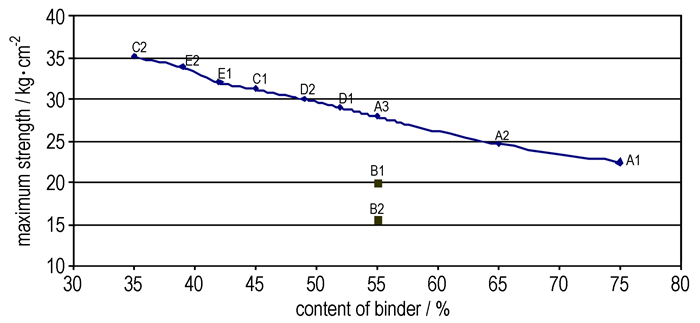
|
Fig.3 Effect of the binder content on the propellant maximum strength |
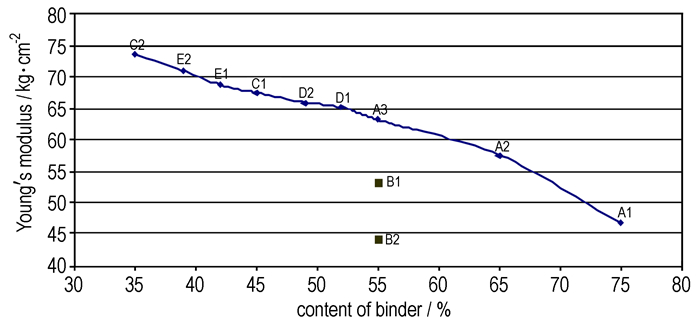
|
Fig.4 Effect of the binder content on the propellant Young′s modulus |

|
Fig.5 Effect of the binder content on the propellant Shore hardness(A) |
Fig. 6 shows the trend of increasing the maximum strain (from 37.07% to 98.08% with a percentage of about 164.8%) when increasing the binder percentage (from 34.5% to 74.5%) in group A, C, D, and E. It is observed that although the binder decreased 4% from E2 to C2 and from D2 to C1 but the effect in maximum strain is negligible. It is clear that incorporate 10% of Al instead of 6% of CC has no effect on the maximum strain.
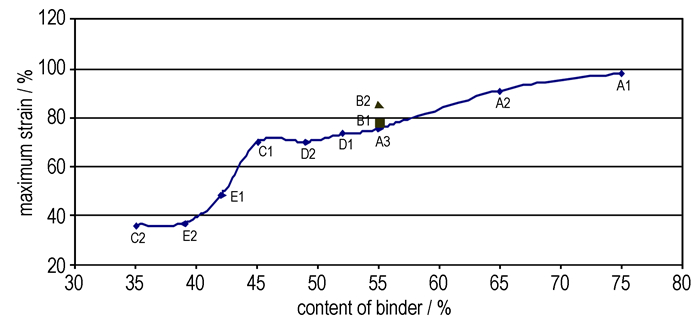
|
Fig.6 Effect of the binder content on the propellant maximum strain |
It is clear that the maximum strain of the composite propellant samples decreases with decreasing the binder content and increasing the solid loading. This effect may arise from the reduced volume fraction of the binder matrix due to the increasing volume fraction of solid particles. When the sample of composite propellant is subjected to uniaxial tensile stresses, the total deformation is accommodated only by the binder matrix because aluminum and ammonium perchlorate particles are hard and possess very high elastic modulus compared to the binder matrix.
Group B has the same binder content as A3 (55%) but with different AP average diameter and this factor has a great effect on the mechanical properties. This will be discussed in the next part separately.
3.2 Effect of the oxidizer particle size on the mechanical propertiesFig. 7 and Fig. 8 present the effect of the oxidizer particle size on the maximum strength and hardness (A) respectively. The larger particle size of AP (9 μm in A3, then 44.5 μm in B1, finally 55.9 μm in B2) without changing the propellant composition, the lower the maximum strength (27.92 kg·cm-2, 20.05 kg·cm-2, 15.64 kg·cm-2) and the lower the hardness (A) (61.25, 53.5, 50.5). This is because the small particle sizes of AP act as active fillers and enhance the mechanical strength of the propellant matrix.
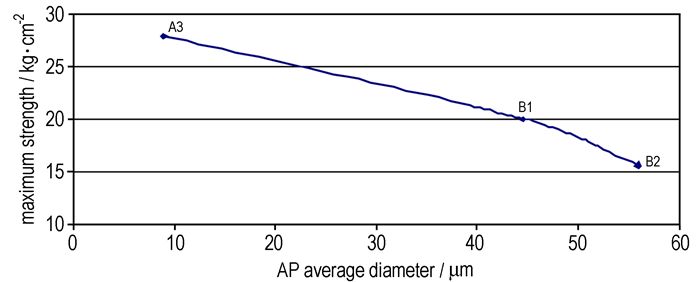
|
Fig.7 Effect of the oxidizer particle size on the propellant maximum strength |
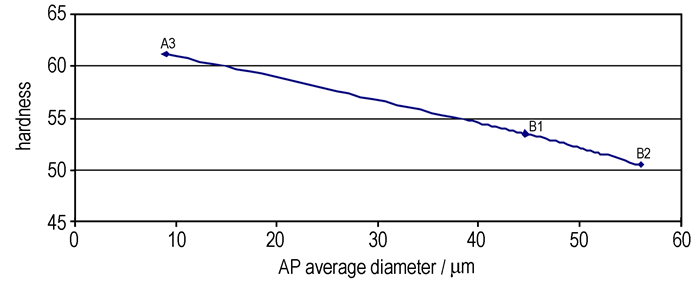
|
Fig.8 Effect of the oxidizer particle size on the propellant Shore hardness(A) |
The polymer system filled with coarse particles starts dewetting at a smaller stress compared to a system containing fine particles. Thus the strength increases with the increasing content of fine particles in the polymer matrix system.
According to Fig. 9 the same trend is found. Young′s modulus is decreased (63.19 kg·cm-2, 53.33 kg·cm-2, 44.24 kg·cm-2) with increasing the particle size of AP.
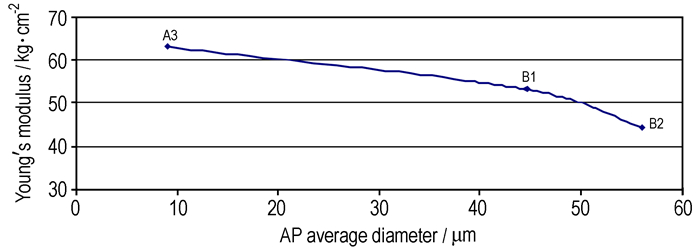
|
Fig.9 Effect of the oxidizer particle size on the propellant Young′s modulus |
Fig. 10 shows the relation between the oxidizer particle size and the maximum strain. The results show that increasing AP particle size within the same binder percentage leads to increase the maximum strain (75.32%, 78.33%, 85.3%) because with increasing the particle size of the oxidizer the apparent volume will be decreased and the distances between the particles will be increased.

|
Fig.10 Effect of the oxidizer particle size on the propellant maximum strain |
Increasing volume fraction of fine fillers reduces the elongation capability of the composite propellant. This behavior caused by different dewetting nature of large and small particles. Vacuoles (vacuum-holes) occur between solid particle and binder phase when the propellant sample dewets. If the load on the sample is maintained, vacuoles enlarge and eventually combine with each other. The volume of the propellant increases during tensile testing due to the presence of vacuoles and due to its combine with each other[15]. This means that these vacuoles contribute to the total elongation after dewetting occurs. Formation of vacuoles in the propellants containing a larger quantity of fine AP is less than that in propellants containing coarse particles. Thus, increasing fine AP fraction decreases the maximum strain.
4 ConclusionThe mechanical properties are so essential for the propellant to be measured to ensure its capability for storage, transportation, aging, and operating under the combustion loads. In this work the effect of solid loading of the fillers in the fuel-rich composite propellants on the mechanical properties was studied. It is observed that as the solid loading increase and the binder percentage decrease from 74.5% to 34.5% the tensile strength increase from 22.51 kg·cm-2 to 35.07 kg·cm-2 and the strain decrease from 98.08% to 36.07% due to formation of additional crosslinks between the solid particles and the network chains of the binder matrix.
The mechanical properties of composite propellants are also strongly affected by the particle size of the ammonium perchlorate. With increasing the oxidizer average particle size (9 μm, 44.5 μm and 55.9 μm) the maximum strength decreases (27.92 kg·cm-2, 20.05 kg·cm-2, 15.64 kg·cm-2) and the maximum strain increases (75.32%, 78.33%, 85.30%) because the apparent volume decreased and the distances between the particles increased.
Much further work is required in this direction to study the effect of AP particle size variations through tri-model systems on the mechanical properties of the composite propellants.
| [1] |
Shalom Abraham, Gany Alon. Flammability Limits and Ballistic Properties of Fuel-Rich Propellants[J]. Propellants, Explosives, Pyrotechnics, 1991, 16: 59-64. DOI:10.1002/(ISSN)1521-4087 |
| [2] |
Davenas Alain. Solid Rocket Propulsion Technology[M]. First English Edition, New Work: Pergamon Press, 1993, Chapter 12.
|
| [3] |
Structural assessment of solid propellant grain[R]. Advisory Group for Aerospace Research and Development, (AGARD). 7 Rue Ancelle, 92200 Neuilly-Sur-Seine, France, Report No. AGARD-AR-350, 1997.
|
| [4] |
Amtower Paul K. Propellant Formulation: US 7011722[P], 2006.
|
| [5] |
GEORGE P Sutton. Rocket Propulsion Elements[M]. Sixth Edition, New York: John Wiley & Sons, Inc., 1992, Chapter 12.
|
| [6] |
Gligorijevi c ' N, Rodic V, Jeremic R, et al. Structural Analysis Procedure for a Case Bonded Solid Rocket Propellant Grain[C]//Scientific Technical Review, 2 011, 61(1): 3-11.
|
| [7] |
Harold E, Marsh Jr. Formulation and Quality Control of Polyurethane Propellants[J]. Journal of Industrial and Engineering Chemistry, 1960, 52(9): 768-771. DOI:10.1021/ie50609a026 |
| [8] |
Hill M E, Coon C L, Ross D L. Structure Property Relationships in Propellant Ingredients[C]//AIAA Paper 78-119, 16th Aerospace Science Meeting, 1978.
|
| [9] |
Ninan K N, BalagandadharanV P, Katherine K B. Studies on the functionality distribution of htpb and correlation with mechanical properties[J]. Journal of Polymer, 1991, 32(4): 628-635. DOI:10.1016/0032-3861(91)90474-W |
| [10] |
Keizers H L J, Hordijik AC, Van Vilet LD, et al. Modeling of Composite Propellant Properties[C]//36th AIAA/ASME/SAE /ASEE Joint Propulsion conference and Exhibit, Huntsville, Alabama, 2000.
|
| [11] |
Timnat Y M. Advanced Chemical Rocket Propulsion[M]. London: Academic Press, 1987.
|
| [12] |
Alain Davenas. Solid Rocket Propulsion Technology[M]. First English Edition, New Work: Pergamon Press, 1993.
|
| [13] |
Makoto Kohga. Burning rate characteristic of AP-based composite propellant using bimodal AP[J]. Journal of Propulsion and Power, 2008, 24(3): 499-506. DOI:10.2514/1.27107 |
| [14] |
Neviere R. An Extension of the Time-Temperature Superposition Principal to non-linear Viscoelastic Solids[J]. Int Journal of Solids and Structures, 2006, 43: 5295-5306. DOI:10.1016/j.ijsolstr.2005.09.009 |
| [15] |
Yilmazer U, Farris R J. Mechanical behavior and dilatation of particulate-filled thermosets in the rubbery state[J]. Journal of Applied Polymer Science, 1983, 28(11): 3369-3386. DOI:10.1002/app.1983.070281106 |
The influence of composition on mechanical properties of fuel-rich composite propellants based on hydroxyl-terminated polybutadiene pre-polymer (HTPB)/ammonium perchlorate oxidizer (AP)/aluminum fuel (Al) was experimentally investigated.




